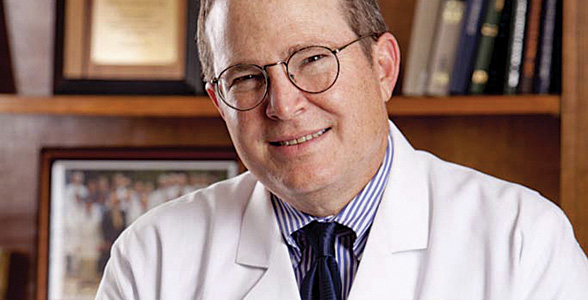By Elizabeth A. Davis
At 100 years of age, the UT Health Science Center could rest on its reputation as the institution that produces most of the health care professionals in the state. But that’s not enough, says Dr. Steve Schwab, UTHSC chancellor.
He is quick to point toward the center’s assets, and he keenly identifies where UTHSC needs to make the biggest improvements for it to become one of the best health science institutions in the country.
UTHSC shines in education and training; it also does well in clinical practice and is improving. Schwab believes UTHSC’s biggest challenge and greatest need is increasing research output and building a national reputation. Accomplishing this goal will help UTHSC discover more ways to treat and cure illnesses, improve training for students and, ultimately, make the lives of all Tennesseans better.
Providing quality training
No one questions UTHSC’s quality of training and education.
“We have outstanding graduation rates, outstanding board-certification rates, and we train a lot of people,” Schwab says. “Our educational performance is very strong.”
With 2,800 students, UTHSC has the largest enrollment in the state for medical, dentistry, pharmacy, and doctoral allied health degrees. The College of Nursing is the largest preparer of doctors of nursing practice (DNPs) and doctors of philosophy in nursing (PhDs) in the state.
When you count the years in school and residency, Schwab estimates 70 percent of doctors in the state engaged with UTHSC for at least one step in their training.
And while many people associate UTHSC only with Memphis, its students and members of its faculty also are located across the state in fifteen hospitals and more than 200 clinical and residency facilities in Knoxville, Chattanooga, Jackson, Nashville, and elsewhere.
“Our colleges span the state. Our students span the state,” Schwab says.
Clinical practice shines
UTHSC shares the land-grant mission of education, research, and public service with the other UT campuses in Martin, Chattanooga, and Knoxville. But the clinical aspect of UTHSC sets it apart. UTHSC derives more than $200 million in revenue from clinical practice, meaning faculty members also are practicing professionals.
Clinical practice pays for part, and sometimes all, of a faculty member’s salary. This is the business side of the Health Science Center. And as in all business, there is competition.
Schwab says clinical performance has improved over the last decade.
“We are contenders in our markets. We have more than doubled the size of our faculty-based practice plans and moved into joint ventures with our training hospitals. We still have a long way to go, but we believe we’re clearly on track.”
In clinical care, UTHSC is known nationally for its work in transplants, trauma, eye disease, and neuroscience. Major advances have been made in pediatric heart disease, pediatric neuroscience, and orthopedics.
Building the research portfolio
In the health care academy, research is the name of the game. It’s where reputations are built.
This is where Schwab says UTHSC needs to make its move. His goal is for UTHSC to be in the top quartile in the Southeast, and research will need a boost to get there.
The top colleges of medicine in the region are Washington University, in St. Louis; Duke University; Vanderbilt University; the University of North Carolina—Chapel Hill; and Emory University.
“If you compare us with other Southeastern university medical centers, we’re in the middle,” Schwab says.
UTHSC reports about $60 million in federal research expenditures a year and hopes to double that. Grants from the National Institutes of Health account for most of the funding. For instance, in 2009, UTHSC was awarded a little over $36 million in grants from NIH, which accounted for 63 percent of that year’s total of $57.6 million in research awards. In comparison, the top medical schools in the Southeast each received more than $200 million from NIH.
“To become a dominant research institution requires a substantial investment. Most of our efforts have been spent raising the dollars to invest in research so we can really drive our research mission. That will take an investment of $10 million to $15 million every year, like clockwork,” Schwab says.
This investment will not come from tuition. And with diminishing state appropriations, the money will have to come from clinical practice revenue and fundraising. It will be spent to hire more faculty researchers and build more research facilities. UTHSC has set specific goals:
- Recruit seventy new faculty members with NIH funding
- Retain existing faculty members
- Facilitate and promote research
- Increase NIH research funding
- Grow industry and foundation grant support
- Increase peer-reviewed publication by members of the UTHSC faculty
- Renovate and build research space
Partnerships also play a role in boosting research. The Complete College Tennessee Act passed last year calls for the creation of the Memphis Research Consortium. UTHSC is partnering with the University of Memphis and St. Jude Children’s Research Hospital in this endeavor.
But the center is not starting from scratch. Some of its departments already have national reputations. The Department of Physiology ranks third among 186 other schools in the United States, Canada, Mexico, and Puerto Rico, according to a survey by the American Physiological Society, which bases the ranking on an institution’s research funding, size of the faculty, and amount of research space. Neurobiology, translational genomics, and biosafety are four research areas in which the Health Science Center excels nationally.
“What we need is not just four—we need ten,” Schwab says. “The caliber of research puts you on the stage.”

